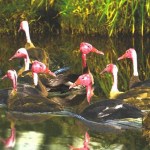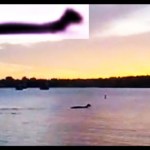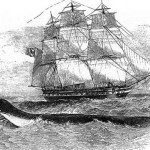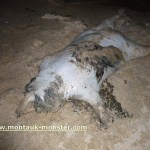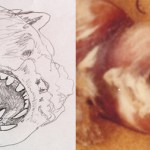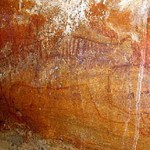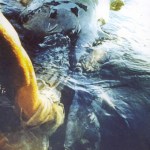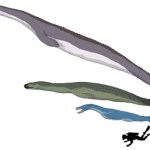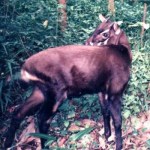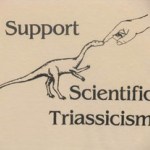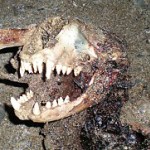cryptozoology
Darren Naish has the full story. In a bygone age without scientists who...know stuff, these sorts of finds would become the germ of myth. As it is we cobble together a bunch of banal facts and likelihoods into something far less exciting, but more likely to b a true description of reality.
So I recently recycled the Madagascar pochard article from Tet Zoo ver 1, first published in 2006. As you might have realised if you read the 2006 article (and if your memory is exceptionally good), I made one major change for the 2009 re-posting: I chopped out the bit about the Pink-headed duck. Why? Because this species is interesting enough to deserve a bit of attention all its own. Here we go...
Once upon a time the remarkable Pink-headed duck Rhodonessa caryophyllacea* - in my opinion easily one of the weirdest ducks of them all - was abundant throughout the floodplains and swamps of…
The big buzz in the cryptozoology community right now concerns a piece of footage taken on May 31st 2009 at Oakledge Park in Burlington, Vermont, and on the shore of Lake Champlain. Lake Champlain is famous in the world of lake monster research as it's alleged to be home to a large, long-bodied animal of some sort: for a previous discussion see my article on the Mansi photo (easily the best known image purporting to show a large, unidentified animal in the lake). The new film was taken by Eric Olsen on his mobile phone: the original version is viewable here on youtube, but can no longer be…
Like most scientific communities, the world of academic tetrapod zoology is an incestuous place. Inspired by a comment made here at Tet Zoo by Matt Wedel - co-author, colleague and one of the three SV-POWsketeers - Cameron McCormick (who works on guppies but is collaborating with Michael Woodley and yours truly on sea monsters) has a new post up at Lord Geekington that I find pretty interesting. Employing the new term 'phylogenetic roulette', he laments the fact that people are inclined to latch on to highly specific identifications when mystery animals are reported, even though critical…
Ever one to jump on a bandwagon, and with another 'mystery carcass' case still all too fresh on the Tet Zoo list of articles, I've decided to blog about this new 'Montauk monster' carcass. In case you've forgotten, back in July 2008 the global media went absolutely apeshit over a rotten raccoon carcass, informally dubbed the 'Montauk monster', and suggested by the uninformed to be some weird genetic experiment, a dead turtle without its shell (duh: THE SHELL IS THE RIBCAGE, IT CANNOT BE MAGICALLY DETACHED FROM THE REST OF THE BODY), or some sort of beaked dinosaur-monster. Yes, if you ever…
Yet again I became distracted the other day, this time by that 'Jaws' photo. The previous article is required reading. Thanks to everyone who provided comments, and had a go at identifying the carcass. While many people suggested 'short-faced dog', a cat identification seems to have been more popular. Time to try to provide some answers...
What can we see from the one existing photo? First off, this animal definitely has small incisors, large canines, and then an assortment of post-canine teeth. This combination immediately rules out loads of possible contenders, most notably diprotodontian…
The Australian mainland's largest extant native mammalian predator is the Spotted-tailed quoll or Tiger quoll Dasyurus maculatus. It weighs, at most, 7 kg. While rumours of Thylacine Thylacinus cynocephalus (15-30 kg) survival persist both in Tasmania and on the Australian mainland (and, incidentally, in New Guinea too), no compelling evidence has yet been presented which might demonstrate survival to recent decades (though there is at least some suggestive evidence). It has been claimed by some that Tasmanian devils Sarcophilus harrisii (maximum weight 11.8 kg) might also still be extant on…
Every now and again a carcass of a large marine animal washes up on a beach somewhere: local people and journalists identify it as a monster, and all hell breaks loose. Inevitably, the carcass turns out to be a decomposing whale or shark. Typically, it now becomes known that a person who arrived at the scene early on stated exactly this, but, because their conclusion was rather boring, it was ignored - or mentioned only in the very last paragraph of a newspaper article. We've looked at this sort of thing before, many times, on Tet Zoo: see the links below.
Last year cryptozoological…
By complete coincidence - honestly! - we looked yesterday at discovery rates among terrestrial mammals. All indications are that many species remain to be discovered. It should also be well known, and I hope it is, that the same is true for large marine vertebrates: recent discoveries, and extrapolations based on discovery rates, indicate that there are still new, large marine animals to find. Today sees the publication of a new paper by myself and two colleagues, Michael Woodley and Hugh Shanahan, in which we attempt to estimate the number of pinnipeds that might remain undiscovered (…
Hopefully it is well known that we still have a lot to learn about the planet's extant macrofauna. And, by 'macrofauna', I'm not talking about nematodes, molluscs or insects but, yes, about such things as mammals. In fact, on mammals specifically, discovery rates indicate that we really should expect the discovery of new species for a long while yet. In a new article in Proceedings of the National Academy of Sciences, Ceballos & Ehrlich (2009) bring attention to the fact that 408 new mammal species (representing about 10% of the total mammal species inventory and belonging to 18…
Oh my god. Two years at ScienceBlogs have passed, and Tet Zoo has now been going for three years. It all started on January 21st 2006 when, for no good reason at all, I started a blog over at blogspot.com. Yes, Tet Zoo is three years old. Time to look back at the past year of operation.
For starters, should you want to know more about Tet Zoo's origin and history of operation, read Happy first birthday Tetrapod Zoology part I and part II (both at ver 1), and Happy second birthday part I and part II. Last year, I included a 'what happened in tetrapods during 2007'. I'm not going to do the…
I've pretty much given up on TV. I occasionally watch a few things (The IT Crowd, Doctor Who, QI, Never Mind the Buzzcocks), but mostly it's all shit and I'd be very happy to not have a TV at all. Once in a blue moon, however, there is something really good. On Friday evening (Jan 16th), BBC 2 screened 'The Mountains of the Monsoon' as part of its The Natural World series. This featured wildlife photographer and environmentalist Sandesh Kadur as he travelled about the Western Ghats in quest of wildlife.
The Western Ghats evidently has some awesome wildlife. There are dholes, tigers,…
Last year the blogosphere and global media went nuts over the 'Montauk monster'. A small mammal corpse that washed up on the beach at Long Island, New York, it was not an alien, government experiment, or sea-monster, as widely claimed by idiots worldwide, but - without doubt - a dead, rotten raccoon. This month a vaguely similar sort of thing is happening, though this time there is less hype. And, for me, the corpse is closer to home, having been discovered on Croyde Beach in Devon, southern England [its skull is shown at left]. The Croyde carcass made several national newspapers, including…
Here we are, at the beginning of 2009. And here's where I get that horrible feeling that - on the 'things to do for 2008' list - so many things remain incomplete. Among these are a number of Tet Zoo posts that were cutting-edge and topical when I started them, yet are now not so cutting-edge, and not so topical. Whatever: here's a brief article I'd planned to publish months ago. It concerns the Bulo Burti boubou Laniarius liberatus, a bush-shrike described in 1991 on the basis of a single individual captured in central Somalia (Smith et al. 1991) [adjacent photo © E. F. G. Smith]. Bush-…
In 1993 a Japanese film crew led by Nadaka Tetsuo succeeded in filming a large animal swimming in the waters of Lake Dakataua on New Britain (the largest island in the Bismarck Archipelago, just north-east of New Guinea). Supposedly, the lake was the haunt of an aquatic creature called the migo or masali, and here - it was claimed - was proof of its existence. Was this, at last, one of cryptozoology's holy grails: definitive footage of a definite monster?
While obscure and quite poorly known, Lake Dakataua and its alleged monster(s) have long been making appearances in the cryptozoological…
Yes, it's true. As revealed by my most redoubtable friend and ally Nemo Ramjet, Amerindian people knew of giant flightless azhdarchids long before their possible existence was hypothesised about here at Tet Zoo (follow-ups here and here). Depicting these animals in their artwork, they symbolised them as the great bird Kaloo: this was the most terrifying of all creatures, a stork-headed, long-necked, quadrupedal, flightless bird with long, three-fingered arms and slim legs. Wow.
I am, of course, joking. Nemo discovered an illustrations of Kaloo in a book on mythology and thought that it…
Both Cryptomundo and Big Cats in Britain have recently showcased the photo you see here.
Taken in Snodland, Kent (UK), earlier this year, it depicts what appears to be a dark, mid-sized felid (NOT a big cat in the proper sense), though the lack of any adequate scale makes its size difficult to judge. Is it just a domestic cat? I want to say that it is, but it just 'looks' larger and more robust, and with chunkier limbs. Superficially, it recalls an African golden cat Profelis aurata, and Loren Coleman has already suggested this (it wouldn't be a big deal if it was, as all manner of exotic…
If you know anything about the literature on marine cryptids - or sea monsters, or sea serpents, or whatever - you will know of the Long-necked seal, a hypothetical mega-pinniped proposed by Bernard Heuvelmans (1968) as the explanation for sightings of giant long-necked sea (and lake) monsters. Based on a number of apparently reliable eyewitness reports, Heuvelmans suggested that this new species, which he dubbed Megalotaria longicollis, was a highly specialised otariid (Otariidae is the group that includes sea lions and fur seals). Giant compared to its relatives (4.5-19 m long), with an…
Well, what an interesting time I've had. Firstly, many thanks to everyone who left a comment - however silly or clueless - on the 'novel Mesozoic archosaur' I posted here a few weeks ago. As those in the know correctly stated, the cartoons depict the Brazilian Cretaceous theropod Irritator challengeri in its original guise as a gigantic flightless pterosaur. Now known without doubt to be a spinosaurine spinosaurid (Sues et al. 2002), Irritator was - astonishingly - first published (Martill et al. 1996) as a coelurosaur and as part of Tom Holtz's Bullatosauria (a since-disbanded…
Unless you've been hiding under a rock, or spending all your time on Tet Zoo, you will almost certainly have heard about the 'Montauk monster', a mysterious carcass that (apparently) washed up on July 13th at Montauk, Long Island, New York. A good photo of the carcass, showing it in right lateral view and without any reference for scale, surfaced on July 30th and has been all over the internet. Given that I only recently devoted a week of posts to sea monsters, it's only fitting that I cover this too. I'm pretty sure that I know what it is, and I'm pleased to see that many other people have…
